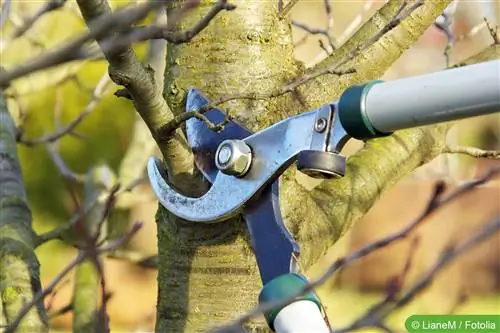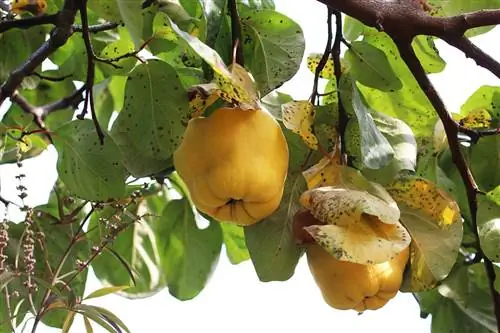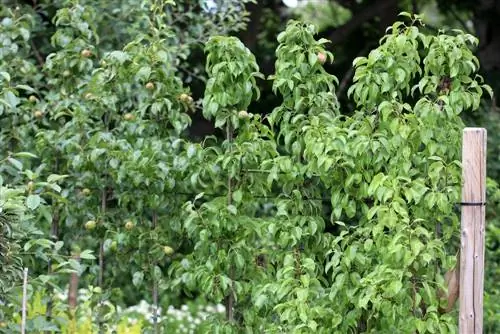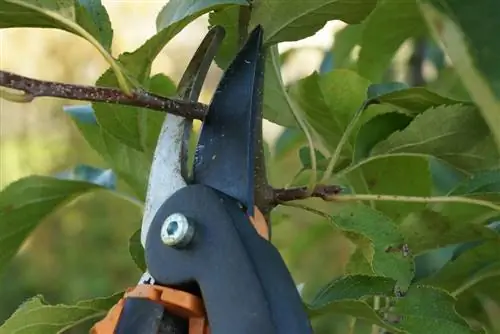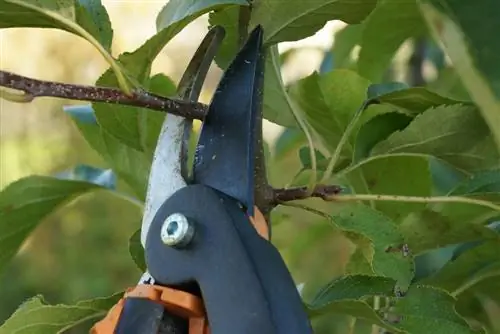- Author admin [email protected].
- Public 2023-12-17 03:39.
- Last modified 2025-01-24 12:45.
Why should fruit trees be cut? On the one hand, it serves tree he alth and yield behavior, and on the other hand, it helps to educate, maintain and rejuvenate the tree. Fruit trees are mainly cut in the months January to March, the so-called winter cut. But a cut is also possible in summer, but this is more of a supplementary and corrective cut. Both cuts also remove damaged tree parts, canker growths and fungal areas. A good fruit tree pruning increases the yield. The tools are also important. For a precise cut, you should use something that cuts reliably and precisely.
Why cut fruit trees?
Proper pruning gives the fruit tree a stable branch structure that can support high harvest quantities. The tree crown is also shaped and corrected if necessary. By cutting out the branches become thinner and dry more quickly after rain, which can prevent pests and fungal infections such as mildew, scab and tree canker. But light and air also penetrate into the interior of the crown and thus promote flower and fruit formation.
Pruning fruit trees has other advantages. Regular pruning keeps the tree young and strong. Winter pruning also encourages new shoots. Special crown cuts are made as privacy screens or for shading and in the commercial sector, fruit tree pruning is also used to produce scions. Of course, the cut must be tailored to the growth behavior of the type of fruit and the development phase of the tree. The right cut, combined with fertilization, soil care and possibly plant protection, guarantees a rich harvest.
When to prune fruit trees?
Winter pruning is the main pruning for almost all fruit trees. The branches are thinned out and the shape cut or tree structure is carried out. Depending on the region, the months January to March are ideal for winter fruit tree pruning. The cut should definitely be carried out on frost-free days. Summer pruning, on the other hand, can supplement or correct winter pruning and should be carried out for pome fruit by the end of July to the beginning of August at the latest. In particular, shoots in the head area or annual shoots that grow straight upwards, so-called water shoots, are removed. Sick branches can also be cut out. However, the summer cut through the foliage is not easy for some hobby gardeners to estimate. You should therefore carry out a thorough winter pruning. The cut is a little different for stone fruit. Pruning here is preferably done in summer or after the harvest. At the beginning of July, the still soft water shoots are cleanly cut off with secateurs. Proper fruit tree pruning can be done on cherries, apricots and early plums after the harvest. However, later-ripening stone fruit varieties should be pruned in winter.
Cutting types
The cutting measures depend on the fruit tree. A distinction is made between:
- Plant cutting
- Educational Cut
- Conservation cut
- Rejuvenation cut
Since the fruit tree loses its roots when it is dug up in the nursery, the crown and root volumes must be adjusted to each other when it is replanted. This planting cut is carried out immediately after planting; it promotes growth and initiates crown training. Training pruning is carried out on all young trees. The aim is to shape the treetop. This can take up to seven years. Through maintenance pruning, the fruit wood is renewed and rejuvenated. It is usually carried out during the harvest period. Rejuvenation pruning is often carried out on older fruit trees. The tree crown is cut back by about a third. This allows the crown to rejuvenate itself with new shoots.
Cutting techniques
- Deriving, targeted fruit tree pruning directs the growth in the desired direction
- Pruning, the complete removal of shoots and branches without any remaining stubs
- Pruning, annual shoots are cut so that they branch out better and become stronger. This pruning is mainly used for training young trees.
The right tool
In order to be able to cut the trees precisely and without injuring the branches, you need good tools such as a saw and pruning shears. These are even available in stores specifically for pruning fruit trees. However, you should definitely pay attention to quality and reliability.
Advantages & Tips
Pruning not only contributes to the optimal he alth of the tree, but also creates a robust branch structure for a correspondingly high harvest yield. A crown that is sufficiently light after cutting has numerous advantages: firstly, it allows sunlight to reach the fruits better and contribute to better development and secondly, the warmth that is created guarantees a kind of protection against fungal infections.
Mildew and co. no longer stand a chance. In addition, experts even say that fruit tree pruning helps ensure that the tree - even if it is already a few years old - remains young and fit.
Incidentally, the cut also has advantages for you: the shade in the garden can be positioned using a clever cut where you can use it and where you can't. Pruning fruit trees in the garden also has a visual impact.
When pruning fruit trees - depending on the type of tree - a distinction is made between winter pruning and summer pruning. The latter in turn varies for pome fruit, berry fruit, stone fruit and walnuts. Here it is particularly important that you inform yourself in advance.
The summer cut is usually the classic and most used cut. This involves cutting back the branches in the area of the tree crown so that the tree becomes a little thinner again. In addition, it is a cut in which the cuts and their developments that may have been planned differently in the winter cut can be corrected if necessary.
Sometimes, such as with walnuts, even just one fruit tree pruning per year is enough. Regardless of the type of fruit tree, the wound healing must be taken into account in each case, which means that pruning may only be carried out when the frost has subsided, otherwise the wounds will no longer be able to recover properly from this procedure.

